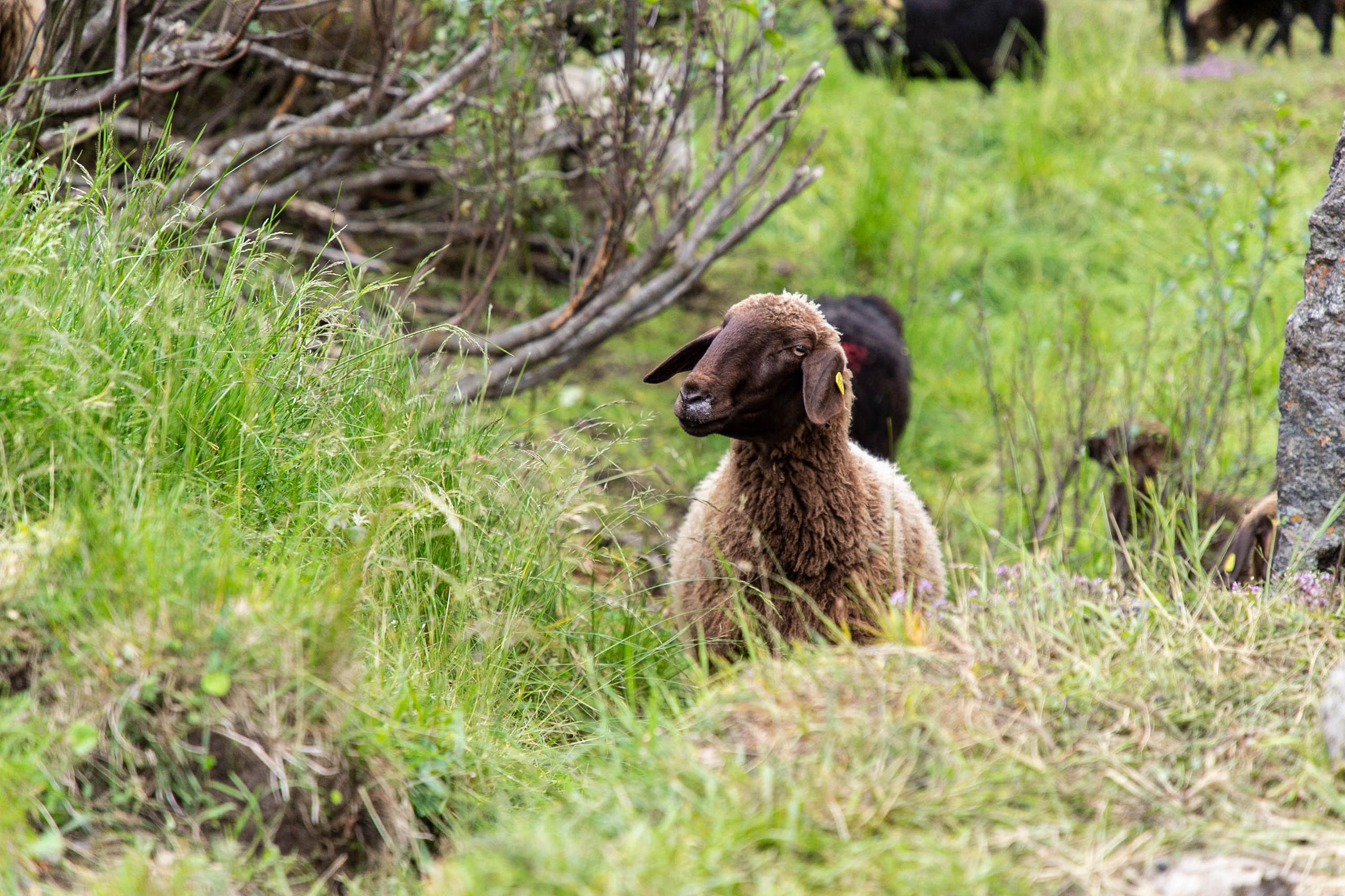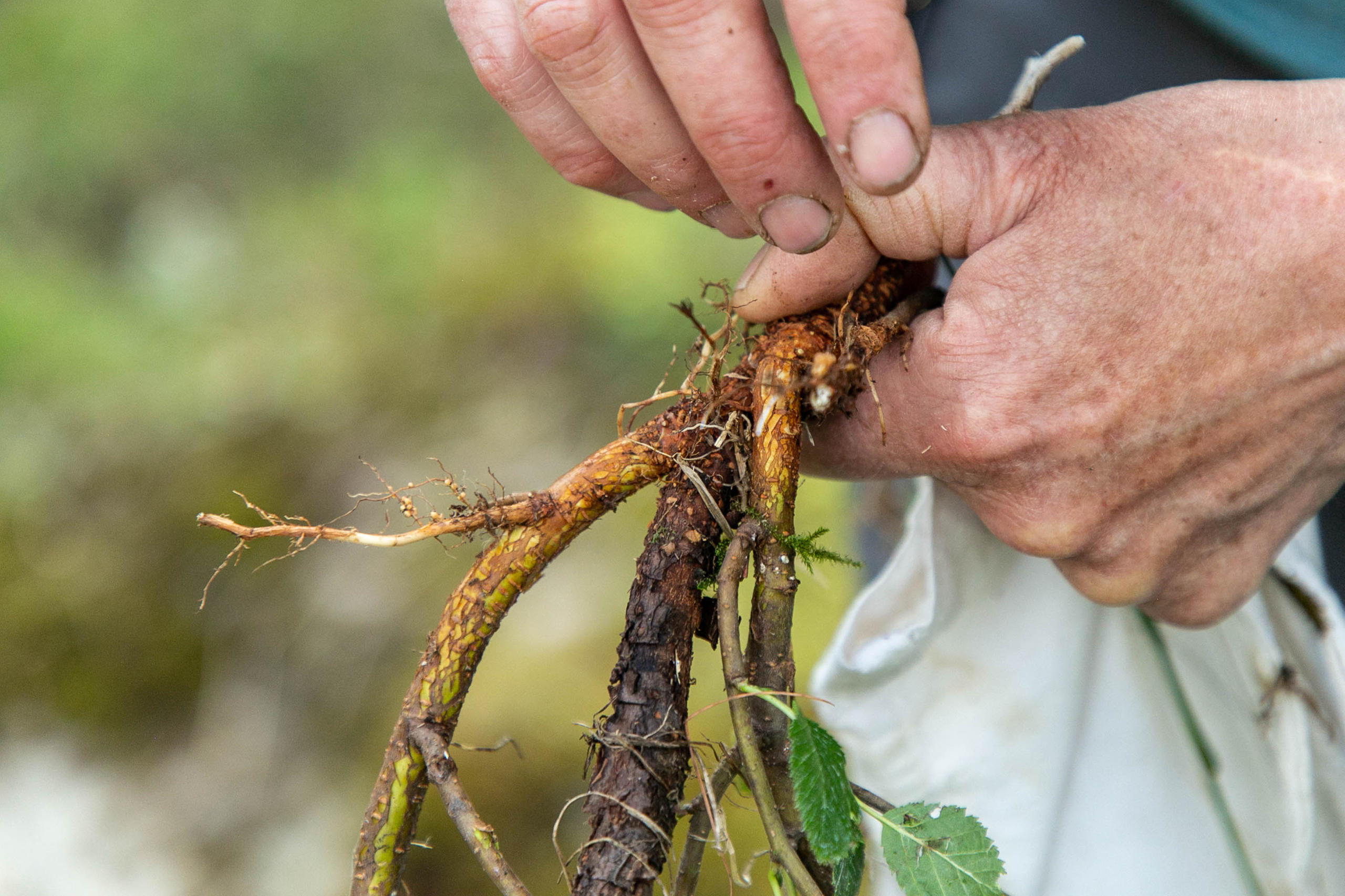
Alpine battles: Swiss sheep fight invasive shrub

Bushes have wiped out 7% of pastures in the Swiss Alps in the past three decades. Other mountainous regions are struggling with the same problem. At the root of this issue is the green alder, a fast-growing shrub that grows into small trees. A project shows what can be done to combat this invasive plant.
The Engadine sheep moves effortlessly on a steep slope. But something is wrong, perhaps a sharp twig caught in her hoof? She bleats and bleats.
Erika Hiltbrunner, a biologist, answers. To no effect – the animal continues to cry. Until she finally receives the answer she wanted: a quieter bleat, a few notes higher, more delicate. The sound of a lamb looking for its mother.

The young Engadine lamb is still drinking milk; its mother is eating the bark of the green alder bushes that grow all around. Chewing is how the Engadine sheep contribute to biodiversity on this slope in the Ursern valley in central Switzerland.
No fat, no interest
Since Engadine sheep gain hardly any fat, they were of little interest for most breeders, and this old Alpine breed almost died out in the 20th century. Now, however, these floppy-eared creatures are experiencing a minor comeback. That’s because they are resilient and trusting – and because low-fat meat is in demand today. But perhaps their most important asset is their eating habits. Other breeds, such as the widespread White Alpine sheep, eat only grass. But Engadine sheep go for the bushes.

“An Engadine sheep that has never seen a green alder before comes here and starts eating,” Hiltbrunner says. She is the managing director of the Alpine Research Station Furka, ALPFOR, which is affiliated with the University of Basel, and is a plant ecologist. And she has grown fond of these trusting animals over the years.
There are currently around 3,400 Engadine sheep in Switzerland. That is the number registered in the herdbook of the Swiss Engadine Sheep Breeders’ Association. But the association estimates that in total, there are around 10,000 of this hardy breed across Switzerland. Even that figure represents only a fraction of the total Swiss sheep population of more than 400,000.
Around 1980, the Engadine sheep, a historic breed, was almost extinct because farmers preferred sheep that grew faster and produced more meat. Today, a close-knit community of around 260 farmers and hobby breeders raise Engadine sheep.
Maël Matile, president of the Swiss Engadine Sheep Breeders’ Association and a farmer, says the Engadine sheep’s fertility is a decisive advantage: unlike most sheep breeds, the animals can get pregnant all year round. On average, the mothers – known as dams – give birth three times every two years. “Many people buy Engadine sheep as dams because of their fertility and cross them with a meat breed,” he says.
It takes a few months longer before Engadine sheep can be slaughtered. According to Matile, their meat is “more tender, almost like game.” His customers particularly appreciate the fact that the low-fat meat of the Engadine sheep does not have the “goaty taste” typical of lamb. Compared to the meat, the economic value of the wool is negligible: It is a matter of a few Swiss francs per animal per year. However, demand for wool is increasing again because building insulation based on sheep’s wool is experiencing a revival.
Swiss Alpine pastures are disappearing under the thicket of a variety of bushes. But the green alder stands out as especially vicious. The agricultural research agency Agroscope, which is affiliated with the Federal Office for Agriculture, writes: “Wherever this bush takes hold, biodiversity decreases immediately.” Adding to the problem, the green alder is by far the most common bush in the Alpine region.
Hiltbrunner notes that where there is “dense green alder growth,” there are 62% fewer plant species than in the open grasslands of the Ursern Valley.

Green alder scrub encroachment is not only a problem in Switzerland. “This species is spreading throughout the Alpine range, in the Pyrenees and the Carpathians,” Hiltbrunner says. “But there are also green alder subspecies in the Himalayas and North America that can be a problem.” In France, for example, Hiltbrunner says the encroachment is tackled by cutting down the green alder. But the plant is a survivor: it takes root again easily. Just cutting it back has very little effect.
A globalised plant
Green alder is found in large parts of the northern hemisphere: in Russia, China, Japan, Canada and as far north as the southern tip of Greenland. According to Agroscope, it stabilises the ecosystem in “its natural habitats, such as streams or avalanche barriers.” The plant is problematic when it gets out of control in “bio-diverse pastureland.”

“Many tourists see the landscape merely as scenery,” says Hiltbrunner, surrounded by Engadine sheep on exactly this kind of pastureland. “They see the greenery and think, ‘This is good.’” They do not see the round coral-like structures that form on the roots of the green alder bushes. Inside these live bacteria which are symbiotic with the green alder. These bacteria accumulate nitrogen.
“It’s like the artificial fertilisers humans produce,” Hiltbrunner says. “In layman’s terms, the green alder has a fertiliser bag permanently at its disposal.” This fertiliser initially helps the plants in the surrounding area, but when the green alder takes over, only a few species remain in its shade.

The nitrogen from the green alder can also acidify the soil and enter the air as nitrous oxide. Nitrous oxide is a greenhouse gas. As a result, mountain slopes with no economic purpose harm the climate.
“According to our calculations, one hectare of green alder produces the CO2 equivalent of a 10,000-kilometre journey in a medium-sized car,” Hiltbrunner says. It was long believed that everything that grew as wood reduced CO2. “For a long time, green alder was treated like forest,” she says.

“But it doesn’t do anything that forests do: It offers no avalanche protection, it has no beneficial purpose, and it threatens diversity.”
The area where the sheep are grazing during our visit was forest 1,000 years ago. Up until ten years ago it was a ski resort. At some time in the past, people cleared the slopes to use them for agriculture. The area was inhabited, as the remains of a stone house reveal. The inhabitants shaped the landscape. Nowadays the masts of the ski lift are rusting away. The land, left to itself, is succumbing to scrub encroachment.
On the ground in front of Hiltbrunner lie the nibbled, dried-out and trampled remains of green alder shoots. Once the Engadine sheep have chewed off the bark, fungi and bacteria can attack the branches of the bush. If the animals are allowed to graze a few summers in a row, a meadow can be reclaimed from the green alders. With the right reforestation measures, the forest could even grow back.

But there is a lack of funds for this. Many of the farmers who manage this land collectively have little interest in actively engaging in scrub clearance. Hiltbrunner’s “sheep project” is currently still running with money left over from a grant by a foundation.
Study confirms effectiveness
Yet no one doubts that the Engadine sheep make a difference. Recently, a joint study by Agroscope and the federal technology institute ETH Zurich, published in the renowned Journal of Applied Ecology, confirmed the effectiveness of the sheep in controlling green alder.
Responding to questions from SWI swissinfo.ch, Agroscope recommended the use of Engadine sheep against scrub encroachment “from an ecological perspective” on an international level, including in other Alpine countries or the Pyrenees, for example. Regions where Engadine sheep could be deployed must also be suitable for them in terms of environmental conditions. In response to “misgivings from a cultural perspective” that arise on occasion, an Agroscope spokesperson writes that “zebus from Asia, llamas from the Andes and Highland cattle from Scotland” are also currently used for pasture maintenance in Switzerland.

A few days after our visit, the Engadine sheep will move to a higher pasture in the Ursern Valley. Hiltbrunner shows the plants already flowering there. “Orchids like these would attract plant fans near the city, but up here they just grow undisturbed.” If the sheep trample a few flowers, new ones will grow again next year. The biologist calls the region a “hotspot of diversity.” It is important to preserve it, she says.
Translated from German by Catherine Hickley/ds
More

In compliance with the JTI standards
More: SWI swissinfo.ch certified by the Journalism Trust Initiative
















![The four-metre-long painting "Sonntag der Bergbauern" [Sunday of the Mountain Farmers, 1923-24/26] had to be removed by a crane from the German Chancellery in Berlin for the exhibition in Bern.](https://www.swissinfo.ch/content/wp-content/uploads/sites/13/2025/12/01_Pressebild_KirchnerxKirchner.jpg?ver=855f1d9f)















You can find an overview of ongoing debates with our journalists here . Please join us!
If you want to start a conversation about a topic raised in this article or want to report factual errors, email us at english@swissinfo.ch.